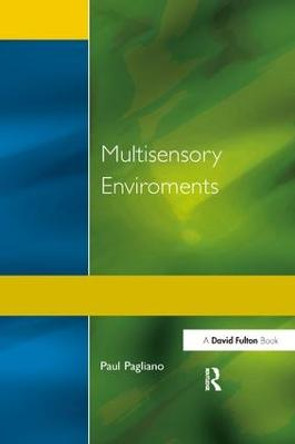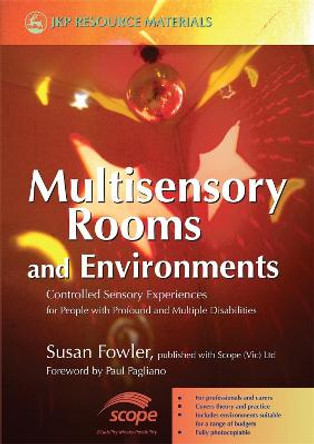Description
Do you support a child or adult with sensory perceptual issues or cognitive impairment?
For people with challenging sensory and cognitive conditions, everyday life can become so unpredictable and chaotic that over time, lack of engagement can often lead to a state of learned helplessness. In this insightful text, Paul Pagliano shows how 'learned helplessness' can be transformed into learned optimism through multisensory stimulation, and explains how a programme of support can be designed and modulated to match the person's needs, interests and abilities. Full of practical, easy to use multisensory assessment tools and intervention strategies, this book will help:
- foster a feeling of ease with the environment
- the child or adult experience pleasure and happiness
- kick-start their desire to explore
- encourage improved learning, social well-being and quality of life.
The author offers an abundance of exciting multisensory stimulation ideas that can be applied to communication, play, leisure and recreation, therapy and education. Practical resources also show how to monitor and review applications to ensure they are being used in the most effective and enjoyable ways possible.
Informed by an astute, up-to-date, comprehensive overview of research and theory, The Multisensory Handbook will appeal to primary professionals from a wide range of disciplines including education, health and social care.
About the Author
Paul Pagliano is Associate Professor in Education at James Cook University, Australia. He has an international reputation as a public speaker, and is on the editorial boards of seven academic journals.
Reviews
'Pagliano reminds us of the importance of recognizing the sentience of all of the individuals with whom we work, regardless of their age. He understands that learning requires processing multiple sensations, that the only way to make sense of the world is through multisensory experiences. This is an invaluable book for anyone who provides any kind of service to people with disabilities.' Professor James M. Kauffman, Ed.D., Professor Emeritus of Education, University of Virginia
'Pagliano ' s text is a fascinating combination of anecdotes, revision of essential knowledge relating to the senses, theoretical exploration, overview of design, and practical tools. It is easy to envisage the text being used as the basis for an entire year of tertiary study. He is to be applauded for such an undertaking, which left me, as a reader, wanting to explore more in order to optimise my engagements with people with multiple disabilities.' Sheridan Forster, Monash University, Australia, 2012
'The Multisensory Handbook has been written to acknowledge the everyday difficulties faced by people living with challenging sensory and cognitive conditions, and how a lack of engagement in everyday activities often becomes a learned helplessness. However, the author Paul Pagliano adopts a positive approach whereby learned helplessness is transformed through multisensory stimulation into learned optimism, by supporting the individual's needs, interests and abilities, thus improving their quality of life.' Diana Schubert, The University of Queensland, Brisbane, Australia, 2013
'Paul Pagliano speaks for people who have 'hands on' experiences in Snoezelen and in Multisensory Environments: both the participants and the practitioners. Those of you who know Paul Pagliano from his many popular public lectures at international conferences all over the world, will know his relaxed, Australian laid-back style when explaining even quite complicated issues. He has a very special gift at being able to talk about intellectual issues in a way that everybody can understand - even those who do not have English as their first language.' Maurits Eijgendaal
' Paul really helps us understand why, even with profound and multiple intellectual and learning disability, how change and improvements in communication can offer an enhanced quality of life. This book is written in a style which is easy to follow and after reading it, I think it will be easy to imagine how you could change your practice to improve the quality of life of your children and students.' Jennifer Crawforde, Dyslexia Review, 2013
'Part I of the book is an enriching read that enhances how we think about the interaction of the senses to gain and use information.' Kim T.. Zabehazy, International Journal of Orientation & Mobility, 2012.
'Throughout the book the author employs a particularly useful strategy of reviewing and linking ideas from previous chapters with new information is subsequent chapters. This spiralling of information helps the reader review the important concepts and provides links to new concepts. This spiralling of information throughout the book echoes the purpose of the book, that as practitioners we need to design appropriate programes to build on new experiences, linking new information with a spiralling effect to aid sense learning.' Rachel Morgan, International Journal of Orientation & Mobility, 2012.
'Pagliano reminds us of the importance of recognizing the sentience of all of the individuals with whom we work, regardless of their age. He understands that learning requires processing multiple sensations, that the only way to make sense of the world is through multisensory experiences. This is an invaluable book for anyone who provides any kind of service to people with disabilities.' Professor James M. Kauffman, Ed.D., Professor Emeritus of Education, University of Virginia
'Pagliano ' s text is a fascinating combination of anecdotes, revision of essential knowledge relating to the senses, theoretical exploration, overview of design, and practical tools. It is easy to envisage the text being used as the basis for an entire year of tertiary study. He is to be applauded for such an undertaking, which left me, as a reader, wanting to explore more in order to optimise my engagements with people with multiple disabilities.' Sheridan Forster, Monash University, Australia, 2012
'The Multisensory Handbook has been written to acknowledge the everyday difficulties faced by people living with challenging sensory and cognitive conditions, and how a lack of engagement in everyday activities often becomes a learned helplessness. However, the author Paul Pagliano adopts a positive approach whereby learned helplessness is transformed through multisensory stimulation into learned optimism, by supporting the individual's needs, interests and abilities, thus improving their quality of life.' Diana Schubert, The University of Queensland, Brisbane, Australia, 2013
'Paul Pagliano speaks for people who have 'hands on' experiences in Snoezelen and in Multisensory Environments: both the participants and the practitioners. Those of you who know Paul Pagliano from his many popular public lectures at international conferences all over the world, will know his relaxed, Australian laid-back style when explaining even quite complicated issues. He has a very special gift at being able to talk about intellectual issues in a way that everybody can understand - even those who do not have English as their first language.' Maurits Eijgendaal
'Paul really helps us understand why, even with profound and multiple intellectual and learning disability, how change and improvements in communication can offer an enhanced quality of life. This book is written in a style which is easy to follow and after reading it, I think it will be easy to imagine how you could change your practice to improve the quality of life of your children and students.' Jennifer Crawforde, Dyslexia Review, 2013
'Part I of the book is an enriching read that enhances how we think about the interaction of the senses to gain and use information.' Kim T.. Zabehazy, International Journal of Orientation & Mobility, 2012.
'Throughout the book the author employs a particularly useful strategy of reviewing and linking ideas from previous chapters with new information is subsequent chapters. This spiralling of information helps the reader review the important concepts and provides links to new concepts. This spiralling of information throughout the book echoes the purpose of the book, that as practitioners we need to design appropriate programes to build on new experiences, linking new information with a spiralling effect to aid sense learning.' Rachel Morgan, International Journal of Orientation & Mobility, 2012.
Book Information
ISBN 9780415597548
Author Paul Pagliano
Format Paperback
Page Count 176
Imprint Routledge
Publisher Taylor & Francis Ltd
Weight(grams) 460g






